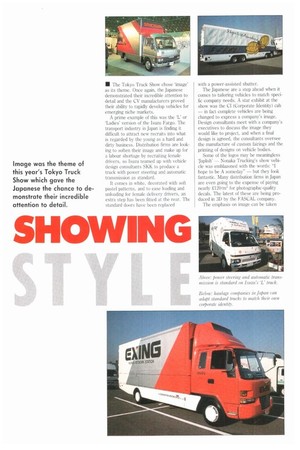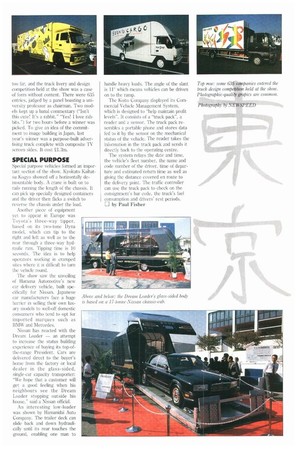SHOWING
Page 44

Page 45

If you've noticed an error in this article please click here to report it so we can fix it.
Image was the theme of this year's Tokyo Truck Show which gave the Japanese the chance to demonstrate their incredible attention to detail.
• The Tokyo Truck Show chose 'image' as its theme. Once again, the Japanese demonstrated their incredible attention to detail and the CV manufacturers proved their ability to rapidly develop vehicles for emerging niche markets.
A prime example of this was the 1' or 'Ladies version of the Isuzu Fargo. The transport industry in Japan is finding it difficult to attract new recruits into what is regarded by the young as a hard and dirty business. Distribution firms are looking to soften their image and make up for a labour shortage by recruiting female drivers, so lsuzu teamed up with vehicle design consultants SKK to produce a truck with power steering and automatic transmission as standard.
It comes in white, decorated with soft pastel patterns, and to ease loading and unloading for female delivery drivers, an extra step has been fitted at the rear. The standard doors have been replaced with a power-assisted shutter.
The Japanese are a step ahead when it comes to tailoring vehicles to match specific company needs. A star exhibit at the show was the Cl (Corporate Identity) cab — in fact complete vehicles are being changed to express a company's image. Design consultants meet with a company's executives to discuss the image they would like to project, and when a final design is agreed, the consultants oversee the manufacture of custom fairings and the printing of designs on vehicle bodies.
Some of the logos may be meaningless — Nonaka Trucking's show vehicle was emblazoned with the words: "I hope to be A someday" — but they look fantastic. Many distribution firms in Japan are even going to the expense of paying nearly 2120/m' for photographic-quality decals. The latest of these are being produced in 3D by the FASCAL company.
The emphasis on image can be taken too far, and the truck livery and design competition held at the show was a case of form without content. There were 635 entries, judged by a panel boasting a university professor as chairman. Two models kept up a banal commentary ("Isn't this cute! It's a rabbit." ''Yes! I love rabbits.") for two hours before a winner was picked. To give an idea of the commitment to image building in Japan, last year's winner was a purpose-built advertising truck complete with composite TV screen sides. It cost .£1.3m.
SPECIAL PURPOSE spccini purnose vehicles formed an important section of the show. Kyokuto Kaihatsu Kogyo showed off a horizontally demountable body. A crane is built on to rails running the length of the chassis. It can pick up specially designed containers and the driver then flicks a switch to reverse the chassis under the load.
Another piece of equipment yet to appear in Europe was Toyota's three-way tipper, based on its two-tone Dyna model, which can tip to the right and left as well as to the rear through a three-way hydraulic ram. Tipping time is 10 seconds. The idea is to help operators working in cramped sites where it is difficult to turn the vehicle round.
The show saw the unveiling of Hamana Automotive's new car delivery vehicle, built specifically for Nissan. Japanese car manufacturers face a huge barrier in selling their own lax
tir to well-off domestic consumers who tend to opt for imported marques such as BMW and Mercedes.
Nissan has reacted with the Dream Loader — an attempt to increase the status building experience of buying its top-ofthe-range President. Cars are delivered direct to the buyer's home from the factory or local dealer in the glass-sided, single-car capacity transporter: "We hope that a customer will get a good feeling when his neighbours see the Dream Loader stopping outside his house," said a Nissan official.
An interesting low-loader was shown by Hamanidai Auto Company. The trailer deck can slide back and down hydraulically until its rear touches the ground, enabling one man to handle heavy loads. The angle of the slant is 11 which means vehicles can be driven on to the ramp.
The Koito Company displayed its Commercial Vehicle Management System, which is designed to "help maintain profit levels". It consists of a "truck pack", a reader and a sensor. The truck pack resembles a portable phone and stores data fed to it by the sensor on the mechanical status of the vehicle, The reader takes the information in the truck pack and sends it directly back to the operating centre.
The system relays the date and time, the vehicle's fleet number, the name and code number of the driver, time of departure and estimated return time as well as giving the distance covered en route to lhe delivery point. The traffic controller can use the truck pack to check on the consignment's bar code, the truck's fuel consumption and drivers' rest periods. El by Paul Fisher
















































































